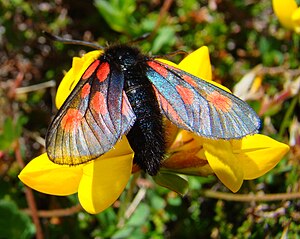High alpine ram
| High alpine ram | ||||||||||||
|---|---|---|---|---|---|---|---|---|---|---|---|---|

High alpine ram |
||||||||||||
| Systematics | ||||||||||||
|
||||||||||||
| Scientific name | ||||||||||||
| Zygaena exulans | ||||||||||||
| ( Reiner & Hohenwart , 1792) |
The ZYGAENA EXULANS ( Zygaena exulans ) is a butterfly ( moth ) from the family of burnet (Zygaenidae).
features
The moths reach a wingspan of 27 to 30 millimeters. They have parchment-like, dull gray (females) to blackish gray (males) forewings on which there is a narrow, elongated spot and four other red spots. The spot on the wing root is wedge-shaped, the rest are oval or round. The hind wings are red with a gray outer edge and black fringes. The body is hairy like many high mountain species. Confusion with other species is ruled out in most cases because of their occurrence at high altitudes. The eggs are relatively large, oval, slightly dented at the top and pale yellow in color. The caterpillars are up to 20 mm long, partly greenish, partly velvety black, with yellowish segment incisions and equally colored oval side spots. They have short, whitish hair grouped in clusters. The doll is brown-black and lies in a gray-white, thin-shelled cocoon.
Occurrence
The species occurs in high areas, so u. a. in the Alps , the Pyrenees , Abruzzo , the Carpathian Mountains and Scotland . The high alpine ram is the only red ram species in Central Europe that can only be found above the tree line , in Switzerland even up to over 3300 meters, in Austria in the Grossglockner region and in Germany in the highest elevations of the Allgäu , but there recently no longer observed. Preferred biotopes are alpine grass heaths and scree meadows.
Way of life
Flight and caterpillar times
The moths fly from June to August and are very common in some areas. However, since they take two years to develop, the frequency differs from year to year. The caterpillars overwinter twice, often in a group of up to 100 animals in a loose web. Pupation takes place in a cocoon that is spun onto rocks.
Food of the caterpillars
The caterpillars are found on many types of plants, but mainly on the following forage plants:
- Yellow sun rose ( Helianthemum nummularium )
- Wundklee ( Anthyllis vulneraria )
- White arum ( Dryas octopetala )
- Stalkless catchfly ( Silene acaulis )
swell
Individual evidence
- ↑ a b c Heiko Bellmann : The new Kosmos butterfly guide. Butterflies, caterpillars and forage plants. Franckh-Kosmos, Stuttgart 2003, ISBN 3-440-09330-1 , p. 56.
- ↑ a b c Walter Forster , Theodor A. Wohlfahrt : The butterflies of Central Europe. Volume 3: Weirdos and Swarmers. (Bombyces and Sphinges). Franckh'sche Verlagshandlung, Stuttgart 1960, DNB 456642196 .
- ↑ Ludwig Osthelder: The butterflies of southern Bavaria . Supplement to the 15th year of the Munich Entomological Society.

